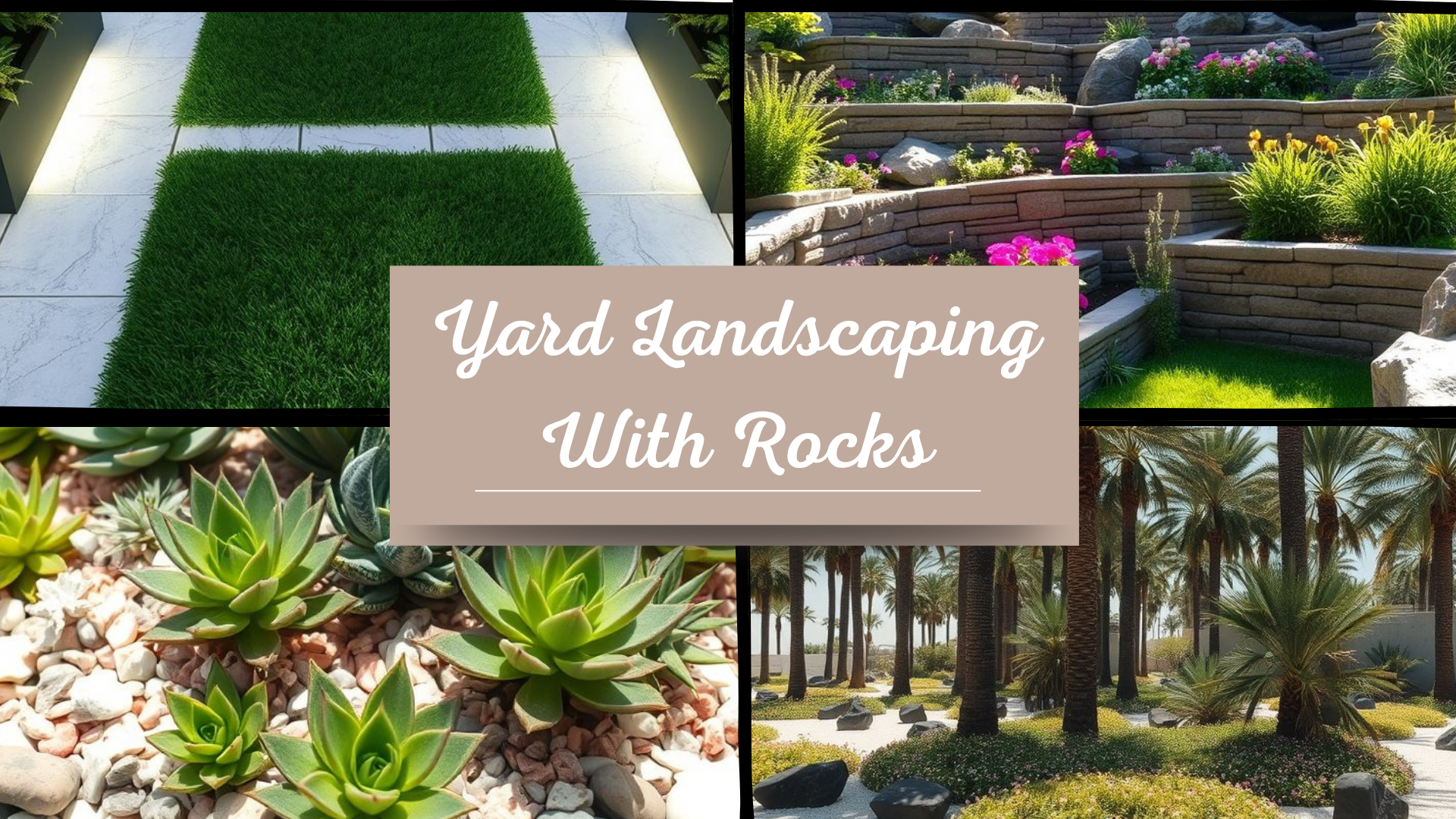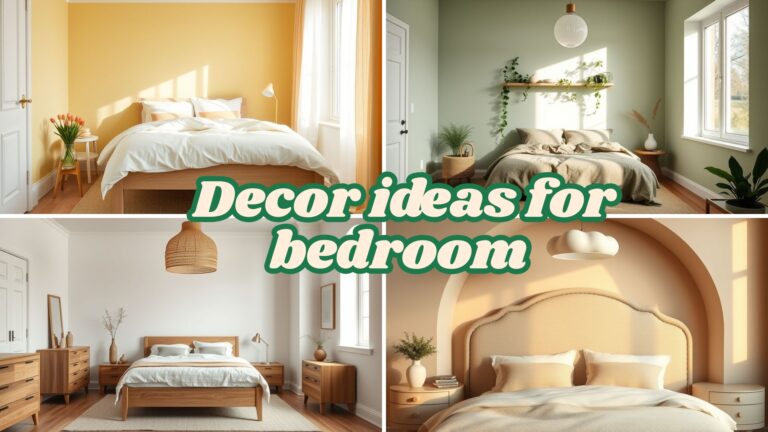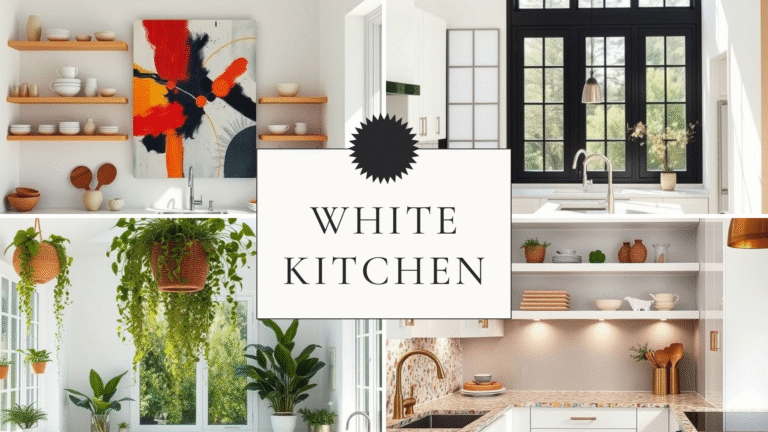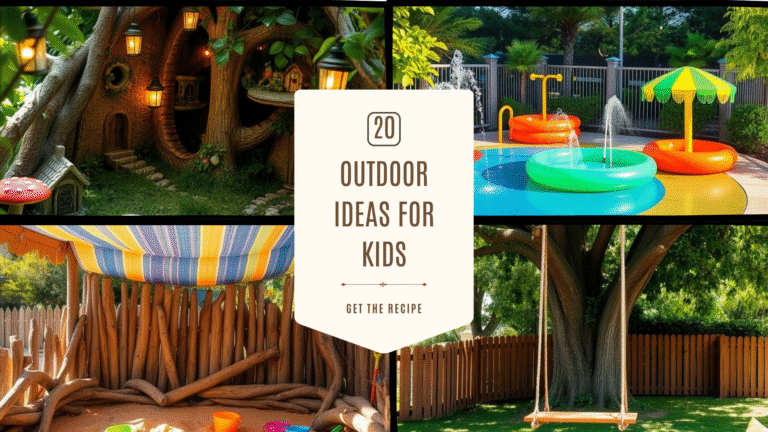Rock Landscaping Ideas: 20 Designs for Low-Maintenance Yards
A rock-forward landscape brings texture, structure, and year-round polish without the upkeep of thirsty lawns. From lava rock borders to zen raked gravel, these ideas balance drama with practicality. Use them to shape pathways, frame planting beds, solve drainage, and create cozy outdoor rooms that look great in every season. Each section below is written in full paragraphs to match the image-based article style.
Lava Rock Border With Dramatic Lighting
Lava rock delivers instant contrast. Its porous surface scatters light, deepening color and adding a rugged, volcanic mood along beds and pathways. A consistent border width reads crisp and intentional, especially against smooth materials like poured concrete or clipped lawn edges. Practicality drives the choice here. Lava’s rough texture suppresses weeds and hides minor debris, so edges look tidy longer with less maintenance. Keep the layer about two to three inches deep to prevent migration in heavy rain.
Lighting takes the look from good to jaw-dropping. Low-voltage strips, pucks, or small uplights tucked just inside the border make the lava glow at dusk. Warm light emphasizes red undertones; cooler light leans modern and charcoal. Plants can amplify the contrast. Silver and blue foliage—think lamb’s ear, dusty miller, blue fescue—pop against black rock, while chartreuse grasses feel electric after dark. Repeat foliage colors in small drifts to pull the eye down the line.
Edging keeps everything in place. Steel or concrete curbs prevent rock creep onto walkways, and they provide a clean visual break between textures. Where the border meets steps, anchor the transition with a larger lava boulder. Safety matters too. Aim lights away from sightlines to avoid glare and keep fixtures slightly recessed, so shoes don’t catch them. With those details dialed in, the border becomes a dramatic frame day and night.
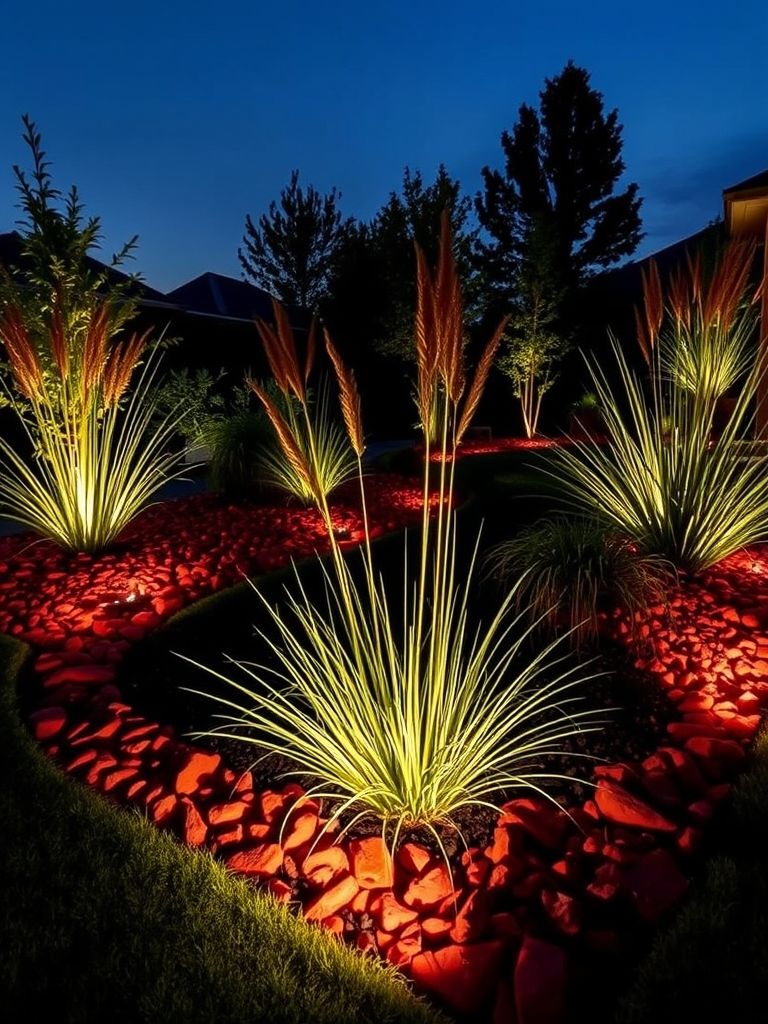
Color-Coordinated Rock Yard With Contrast Stones
Pick one dominant rock color and stick with it. Buff, gray, or charcoal can each set a calm baseline that makes the space feel composed rather than chaotic. Limit the accent color to small areas so contrast feels curated instead of busy. Proportion is the secret. An 80/20 split—eighty percent main stone, twenty percent accent—creates rhythm without overwhelming the eye. Repeat the accent in short bands near entries or seating areas to guide movement.
Shape consistency also matters. Rounded river rock pairs best with rounded cobbles, while angular gravel wants angular chips. Mixing shapes muddies the read; staying consistent keeps patterns sharp. Clean separations make colors sing. Slim steel or paver edging prevents stones from mixing over time and keeps maintenance easy. It also sharpens curves and corners so patterns feel intentional.
Plants can echo the palette. Silvery foliage softens gray and charcoal, while warm greens and tawny grasses complement buff tones. Keep species limited and repeat them in drifts to maintain cohesion. Depth finishes the job. A uniform two- to three-inch topdressing prevents bald spots and hides irrigation lines. With color, proportion, and edge control, the yard reads modern, tidy, and easy to care for.
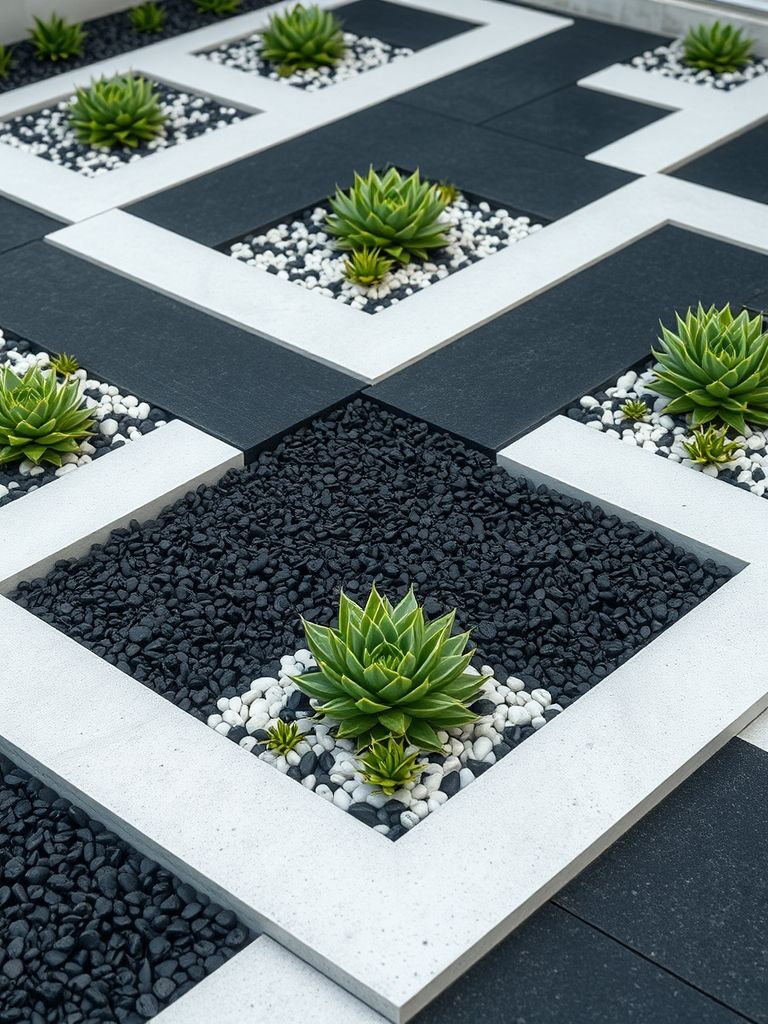
Desert Landscape With Succulents and River Rock
Desert planting is about bold silhouettes and water-smart choices. Agave, aloe, barrel cactus, and ice plant deliver form and seasonal color with minimal fuss. Group plants in threes or fives at varied spacing to mimic natural colonies.
River rock is the perfect mulch here. It moderates soil temperature, reduces evaporation, and provides visual calm beneath sculptural plants. Switch sizes across zones—fine gravel for paths, one- to two-inch river rock for beds, and larger boulders as focal punctuation.
Negative space is not empty; it’s intentional breathing room. Decomposed granite or compacted sand highlights plant forms and keeps the composition from feeling crowded. The result is airy and graphic, not barren. Irrigation should be discreet and efficient. Drip lines on a timer keep roots hydrated without splash on leaves or wasted runoff. Bury lines shallowly and pin them before covering with rock.
Material accents add warmth. Rusted steel planters, corten edging, or a charred wood bench bring rich tones that play beautifully against cool stones. Keep furniture low and sturdy to match the landscape scale. Maintenance is straightforward. Remove weeds early, top up rock as needed, and prune to preserve each plant’s sculptural outline. The landscape will only grow more striking as plants mature.
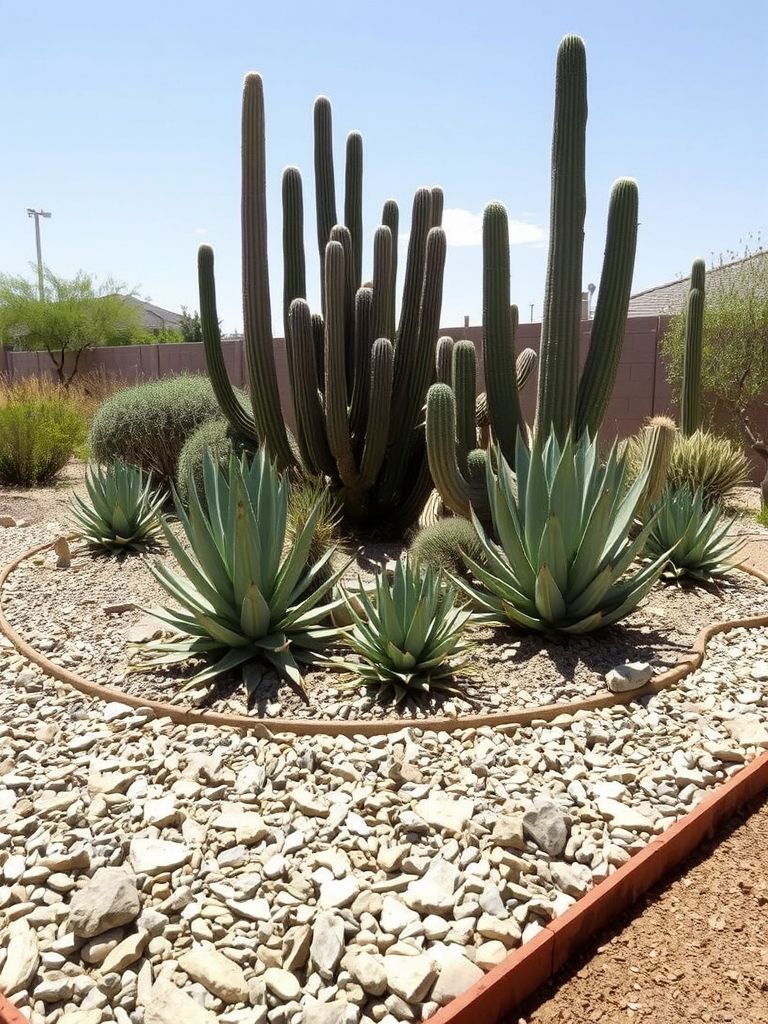
Japanese-Inspired Rock Waterfall Garden
A small cascade can transform a corner into a meditative retreat. Stack flat stones to create gentle drops and hide the pump intake among rounded river rock. Aim for the sound of water over stone rather than splashy noise. Planting softens edges and suggests age. Moss, ferns, dwarf conifers, and Japanese forest grass knit the composition together without stealing focus. Keep the palette limited so textures do the talking.
Balance “void and solid.” Open gravel areas let the eye rest, while stone clusters ground the scene. The interplay creates depth in a compact footprint. A curved stepping path encourages slow movement. Place stones with comfortable stride and a slight crown for drainage. Avoid straight lines, which feel rushed and out of character.
Restraint makes it believable. Two rock types, three plant families, and one small artifact—perhaps a stone basin or lantern—are plenty. Over-decorating breaks the spell. Lighting should be barely there. Soft, low uplights on a single specimen and a hint of path light keep the mood calm and intimate after dusk.
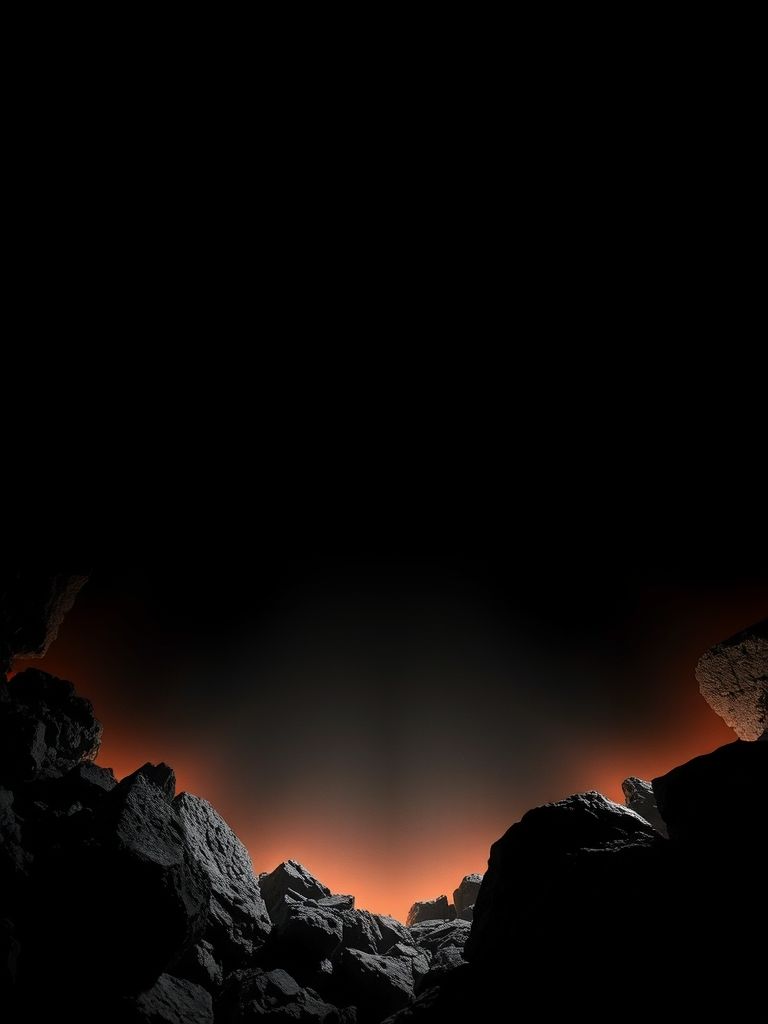
Layered Boulder Landscape With Mountain Vibes
Boulders read as authentic when they look as if they tumbled into place. Use one large “hero” stone, a few mediums, and several smalls so the eye can step down naturally. Vary orientations and rotate faces until the composition feels effortless. Bury boulders for realism and stability. One-third below grade is a good rule, with drainage gravel beneath heavy pieces. Exposed stones sitting on the surface always feel wrong.
Soils should drain fast. Backfill pockets with gritty mix to prevent rot and frost heave. You can tuck alpine perennials and low sedums into crevices once the structure is set. Circulation should feel like a mountain trail. A narrow, winding path that threads between boulders increases perceived depth and makes the garden feel discovered. Keep edges soft and irregular.
Gravel color ties it all together. Cool gray fines mimic mountain scree and make greens and blues glow. Add a few lichened or weathered rocks for instant age. Maintenance is minimal. Trim plants lightly, blow leaves from gravel, and check settling after heavy rains. The arrangement will look better each season as mosses and patina develop.
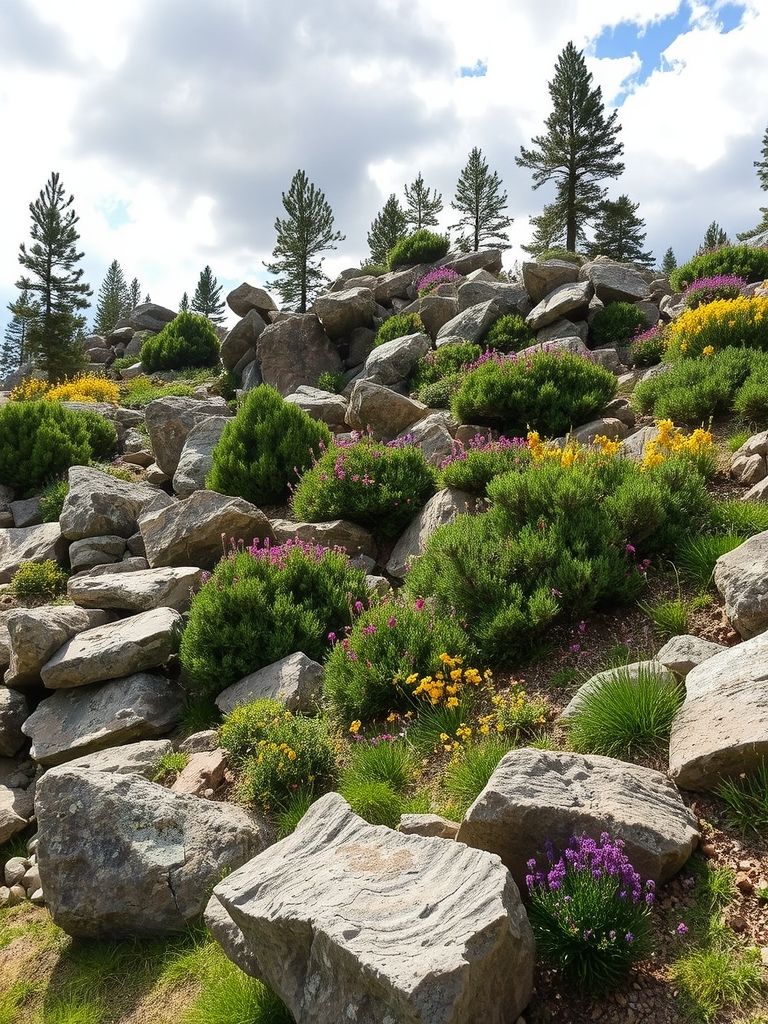
Minimalist Rock Courtyard With Steel Edging
Minimalism depends on clarity. Choose a single gravel color and size for the field, then frame it with weathered steel edging. The warm rust hue brings depth without adding visual noise. Furniture should be sculptural and spare. A floating concrete or ipe bench offers a quiet invitation without clutter. Keep accessories to one or two pieces at most.
Introduce one living focal point. A multi-stem tree—olive, Japanese maple, or desert willow—adds movement and seasonal interest. Plant it in an off-center position to avoid symmetry’s stiffness. Light the edges, not the middle. Slim spikes that wash the steel face create a soft glow line and define boundaries at night. Hidden fixtures keep the composition quiet.
Add a narrow planting strip to soften geometry. A ribbon of grasses or low sedges along one edge creates a tactile counterpoint to the hard lines. Repeat a single species for calm. Clean-up is simple. Rake the gravel to refresh patterns, blow leaves away from the tree basin, and top up aggregate annually. The space stays sharp with minimal effort.
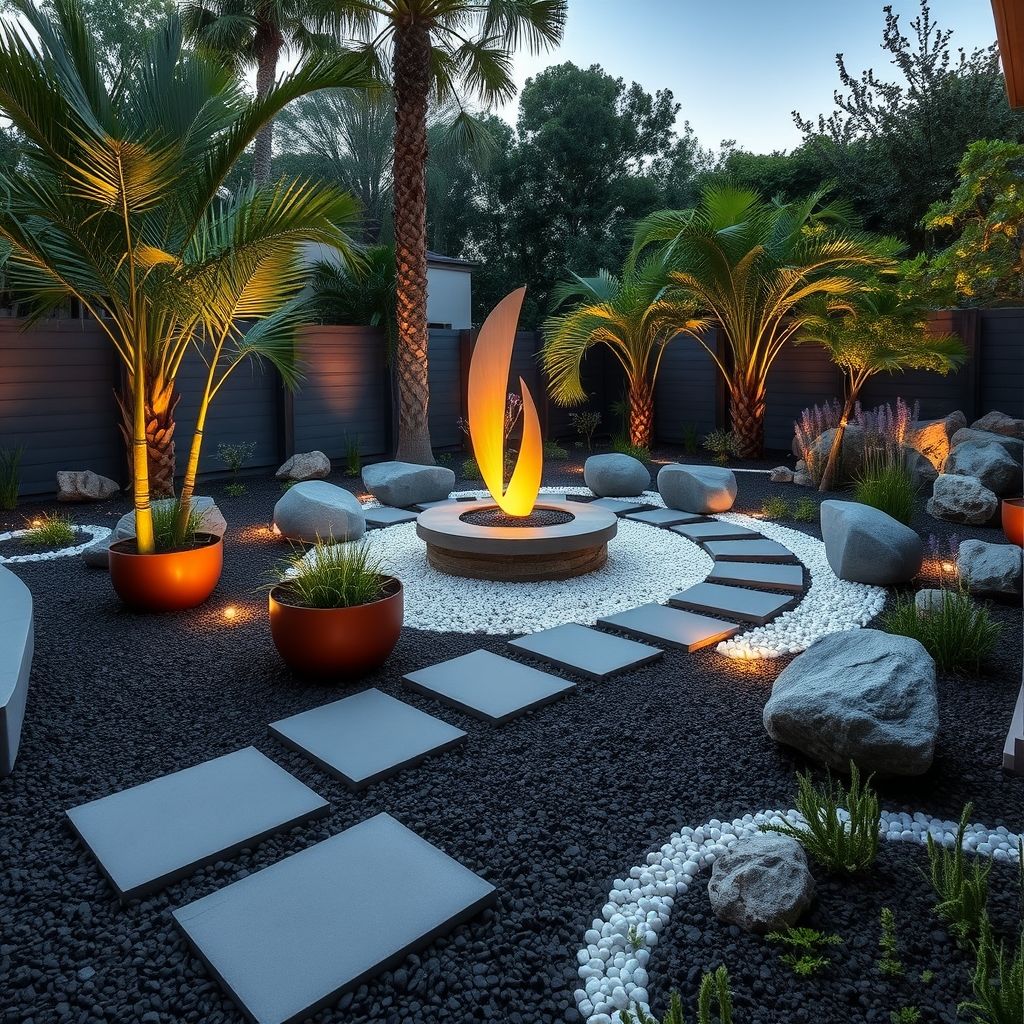
Modern Rock Pathway With Geometric Stepping Stones
Geometry sets the tone. Lay oversized pavers in a repeating grid, then fill joints with fine gravel for drainage. Consistent spacing creates a comfortable stride and a crisp, architectural look. Edges keep the grid intact. Slim steel or cast-in-place concrete restrains gravel from creeping onto paver surfaces. Clean corners are what make the design read modern.
Planting should underline the geometry. Low, linear bands—dwarf mondo grass, creeping thyme, or liriope—trace the grid and soften edges without obscuring the pattern. Keep heights low for contrast with broad paver faces. Nodes deserve emphasis. Where paths meet, introduce a cube planter, a square boulder, or a compact light to create a small moment. Repeating the same object keeps the language coherent.
Lighting reinforces order. Short bollards or low downlights cast tidy pools, making the grid visible after dark. Avoid tall fixtures that add visual clutter. Maintenance is mostly about joints. Top up gravel annually and brush it back into gaps after heavy use. With those touches, the pathway stays legible and inviting.
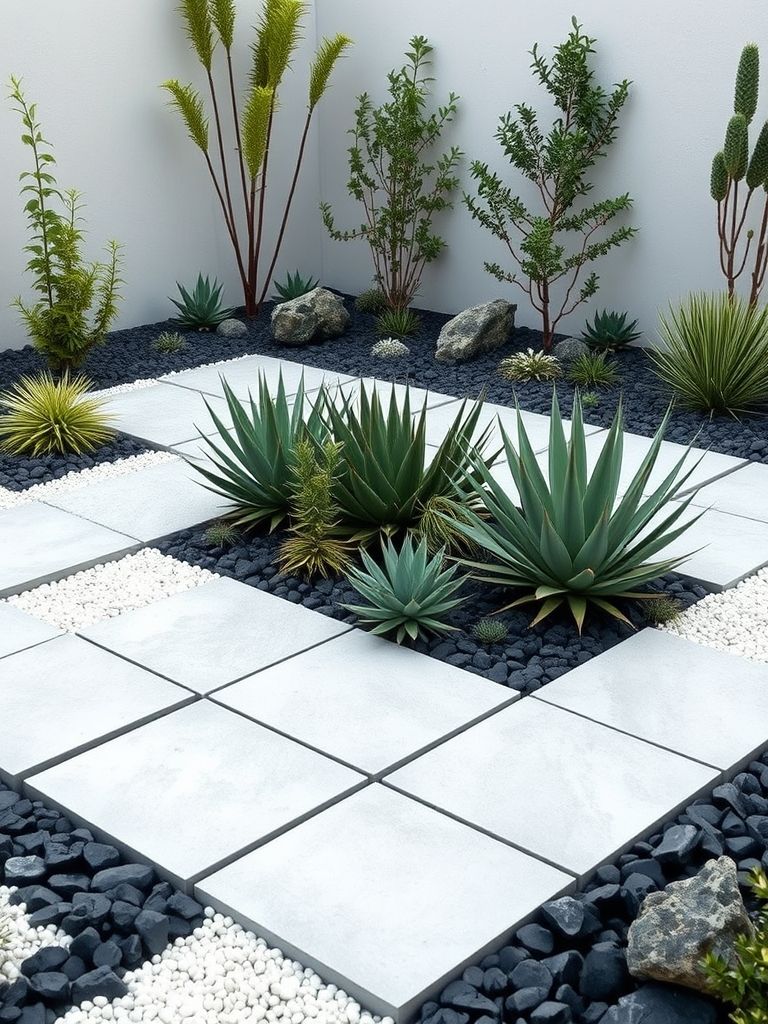
Moss and Rock Shaded Garden Path
Shade gardens thrive on texture. Moss is the magic that stitches stones together into a serene green carpet. Choose rough, moisture-holding rocks and allow shallow basins where rain lingers without pooling. ;Traffic needs guidance. Set stepping stones where feet naturally fall and let moss fill the spaces between. The stones protect the moss and create a rhythm beneath the canopy.
Understory companions complete the mood. Hosta, heuchera, ferns, and woodland anemones add height and soft, layered foliage. Keep blooms subdued so the green tapestry remains the star. Moisture is maintenance. In dry spells, mist lightly to preserve lushness, especially on new transplants. Mulch with leaf mold at the margins to build a soft forest floor.
Light should be dappled, not direct. Prune high branches to invite mottled sun, which fuels moss without scorching it. Avoid overly dense shade that becomes stagnant. The result is hush. Footsteps slow, sound softens, and even small spaces feel deep and cool. It’s a path you wander rather than rush.
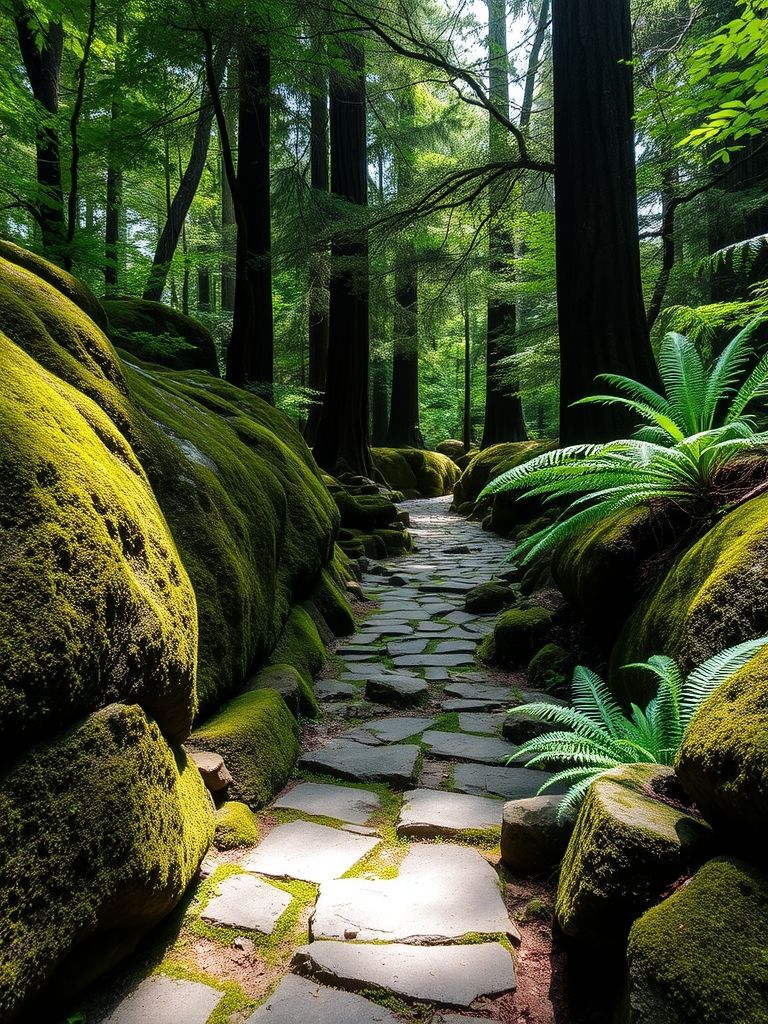
Pebbled Front Yard With Spiral Rock Mosaic
Curves bring energy to the front yard. Sketch a spiral with a garden hose, refine it with chalk, and commit once proportions feel right from the street and the porch. The motif draws the eye to your entry with playful grace. Contrast defines the design. Pair white pebbles with black or charcoal with buff to keep the spiral legible at a glance. Work from the center outward so curves stay tight and clean.
Base prep matters. Compact a sand or fines layer and set stones flush so the surface is walkable. A firm foundation prevents sinking and preserves the pattern. Planting should be minimal. One specimen tree, a few groundcovers, and maybe a low hedge allow the mosaic to star. Over-planting distracts from the graphic.
Sealing is optional but impactful. A penetrating sealer deepens color and keeps dust down, especially in dry climates. Test a small area first to ensure you like the finish. Daily life stays easy. Blowers clear debris quickly, and the spiral remains eye-catching through all seasons with nearly no watering.
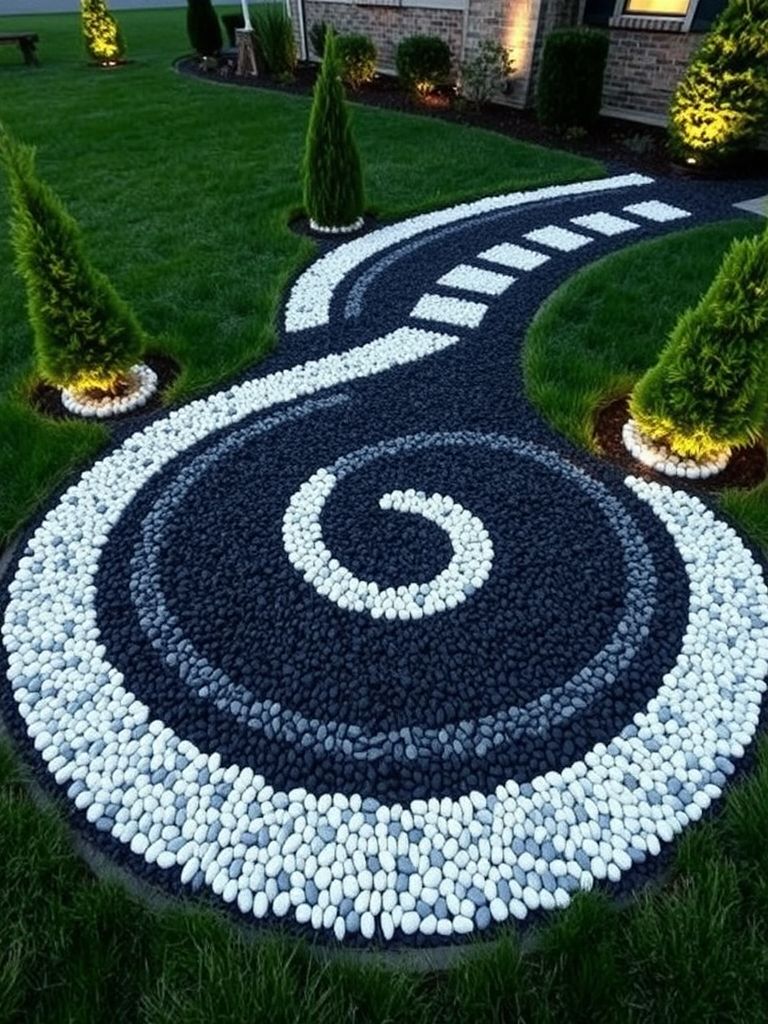
Raised Rock Beds With Ornamental Grasses
Height changes make modest yards feel layered. Low, dry-stacked stone rings lift plantings and create instant focus. Vary diameters and heights so each bed feels intentional, not identical. Fill with free-draining mix and top with three-quarter-inch gravel to keep crowns dry. The gravel also provides a neat visual base that links multiple beds.
Grasses bring movement and glow in low light. Fountain grass, blue fescue, and feather reed grass sway and catch the sun, adding life to the stone structure. Plant in drifts for cohesion. Evergreens add winter bones. One small shrub per bed—dwarf holly, compact juniper, or boxwood—keeps the composition from going flat in the off-season. Prune lightly to maintain form.
Repeat elements to tie the yard together. Use the same stone and a limited plant palette across beds so the eye reads the space as one design. Variation comes from height and spacing. Place taller grasses at the back of views to frame and conceal utilities. The beds become functional screens as well as decorative features.

Rock and Grass Checkerboard Yard
A checkerboard reads playful and precise. Alternate square pads of turf with equal squares of gravel or pavers to create a graphic lawn substitute. The pattern adds structure without feeling rigid. Scale to the space. Larger squares calm a big yard; smaller tiles add energy in compact courtyards. Keep gaps uniform for a polished finish.
Base and drainage are key. Under rock squares, compact fines; under turf squares, use well-draining soil so edges don’t slump. A level plane keeps the board crisp. Choose resilient grass. Dwarf fescue or zoysia handles foot traffic and heat, while synthetic turf can reduce maintenance in harsh climates. Keep pile height similar to stone depth.
Edges need attention. Steel or hidden paver edging prevents migration between squares, preserving lines through seasons and mowing cycles. It also simplifies trimming. Maintenance balances both materials. Brush gravel back into place and mow on a high setting to protect turf health. The result is a playful surface that doubles as an entertaining zone.
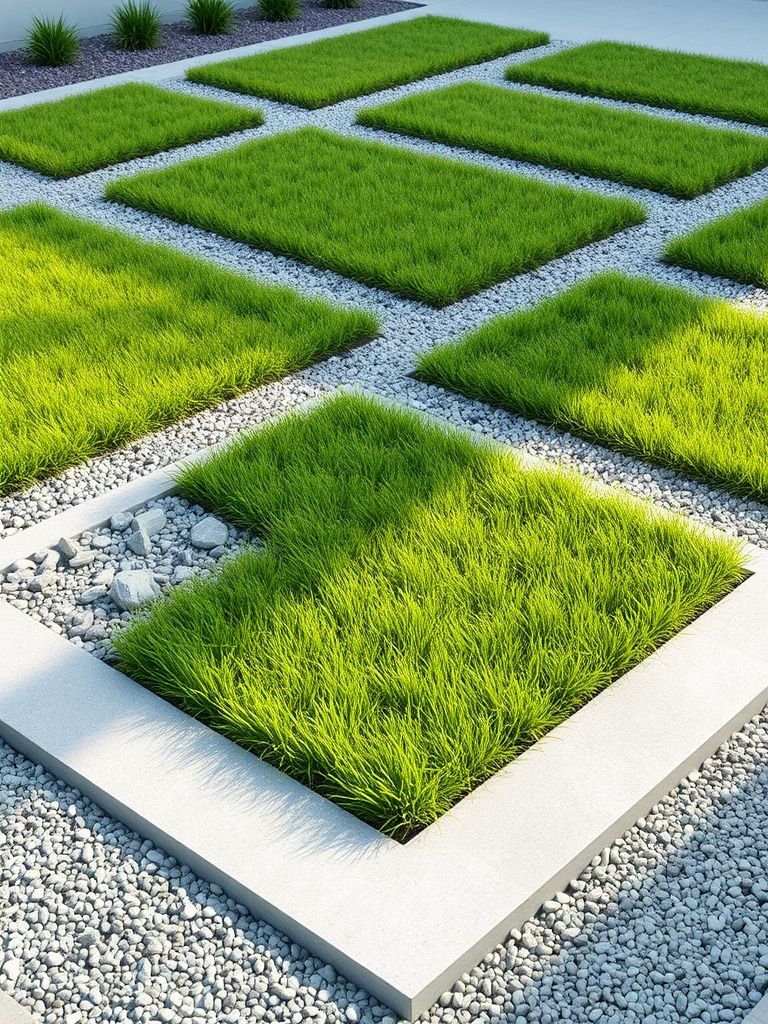
Rock and Wood Mix Landscape for Small Yards
Combining warm wood with cool stone makes tiny spaces feel curated. A compact deck or stepping wood slats set into gravel creates a rhythm of textures underfoot. The mix brings both comfort and durability. Built-in planters extend the palette vertically. Timber boxes lined with membrane pair beautifully with a gravel field, giving roots depth without stealing floor space. Repeat the deck wood for cohesion.
Scale furniture thoughtfully. A narrow bench, folding bistro set, or corner daybed keeps circulation open. Avoid bulky pieces that crowd the composition. Use lighter gravel to brighten shady walls, and darker stone to ground sun-blasted corners. Color tuning can change the perceived temperature of the space.
Lighting should be low and warm. LED stringers under bench lips or spike lights grazing wood grain turn the yard into a nighttime lounge. Keep hardware minimal to avoid visual clutter. Maintenance is simple. Sweep the wood, rake the gravel, and refresh planter soil each season. The contrast of materials does the heavy lifting.
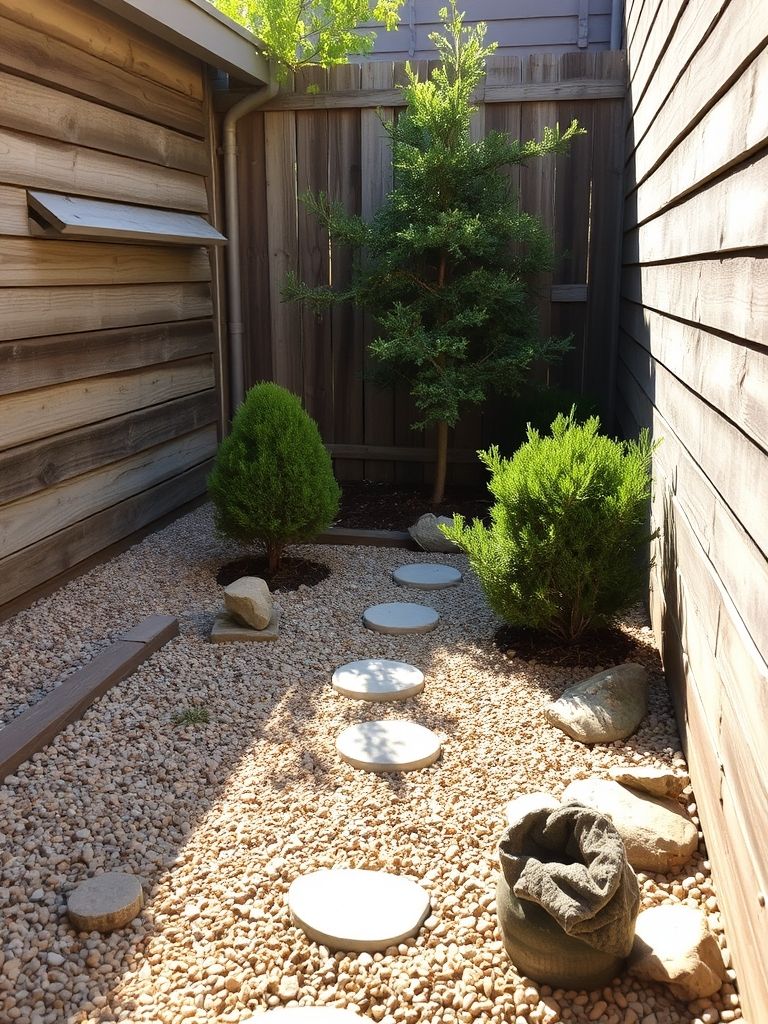
Rock Circle Seating Area With Pergola
Circles invite gathering. A crushed-stone patio edged with a ring of larger cobbles sets the stage for conversation. The curved perimeter softens fences and straight house lines. A pergola adds vertical room and filtered shade. Proportion the posts to the circle so the frame feels tailored, not tacked on. Overhead beams align with seating zones to define sub-areas.
Furnish with curved benches or flexible chairs that can reorient around a fire bowl. Round forms keep the circle feeling generous and inclusive. Plant the rim with low grasses and herbs so the stone ring reads cleanly. A few upright accents—like compact bay laurel or rosemary standards—create cadence without blocking sightlines.
Vines make the pergola lush. Choose lightweight climbers like star jasmine or honeysuckle for scent and seasonal bloom. Keep growth thinned to preserve dappled light. At night, layer light. Soft stringers overhead, tiny spikes at the cobble ring, and a couple of lanterns on tables make the circle glow without glare.
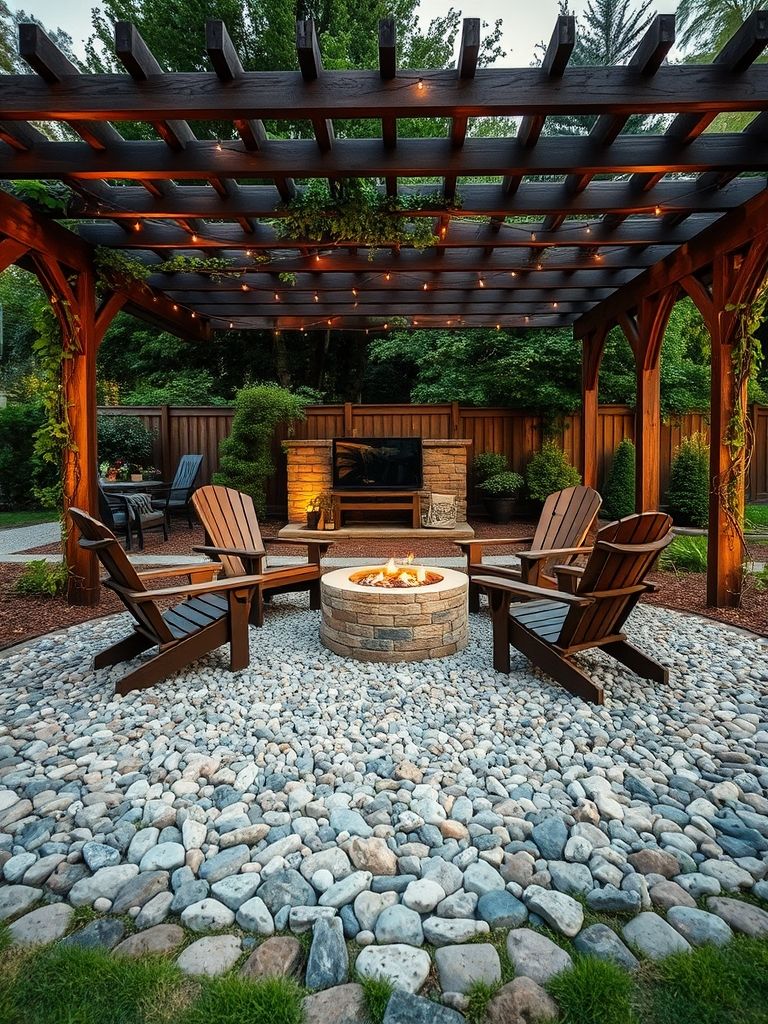
Rock Dry Creek Bed For Drainage Landscaping
A dry creek is form meets function. It guides roof or slope runoff through the yard while reading like a natural feature. Meander the line gently and widen at bends for realism. Rock sizing tells the story. Use larger “bank” stones at the edges, mid-size cobbles in the middle, and fine gravel as the stream “bed.” The gradation looks authentic and slows flow.
Add micro-weirs. Small stone riffs across the bed create tiny pools that slow water further and invite infiltration. They also add sound during storms. Plant the banks, not the bed. Grasses, sedges, and natives knit the edges while keeping the channel clear for movement. Keep roots out of the central flow path.
Tie in downspouts with hidden piping that daylight into the creek. Cover outlets with rock to disguise hardware and dissipate energy. Upkeep is light. Remove leaves and silt after big storms and top up fines annually. The creek becomes a signature line that solves a problem beautifully.
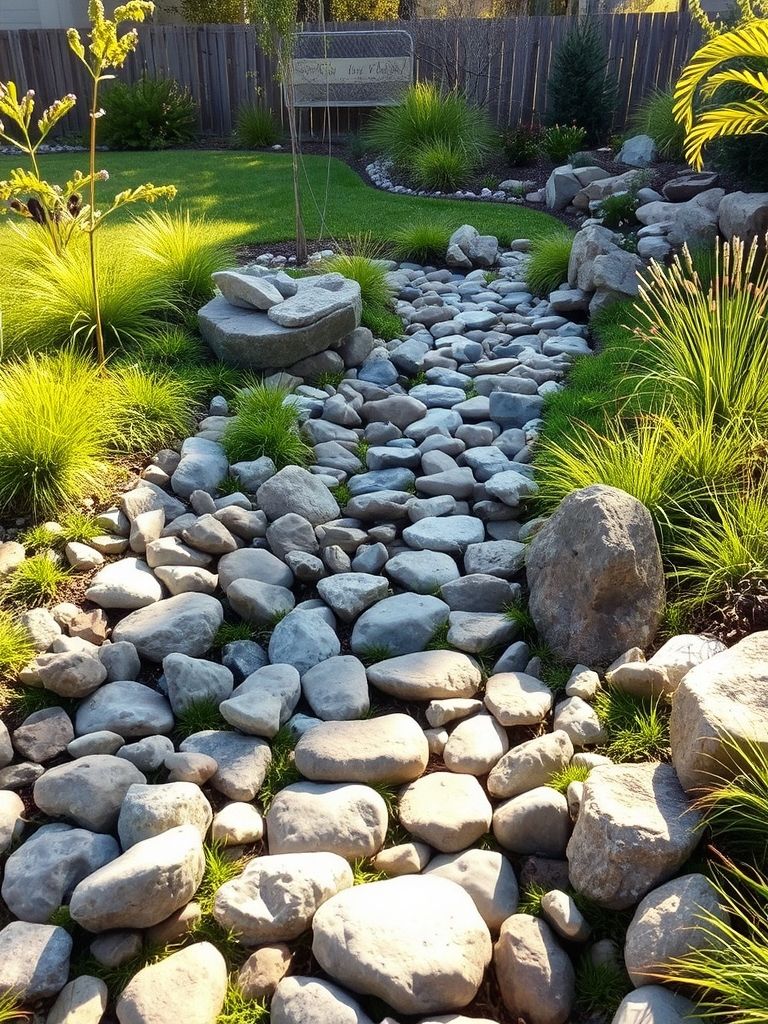
Rock Fire Pit Lounge Area
Fire draws people in. Decide early between wood-burning romance and gas convenience, then set clearances based on local code and safety. A stone or gravel floor keeps sparks away from turf. Shape the pit to the seating. Round pits with curved benches feel communal; square pits with low lounge chairs read modern. Keep seat heights consistent so conversation flows.
Wind matters. Position the pit so prevailing breezes carry smoke away from doors and neighbors. Low stone windbreaks double as backrests and help channel airflow. Material continuity helps. Use the same stone for pit, seat wall, and edging so the space reads like one built element. A darker gravel underfoot hides ash better than pale tones.
Light the perimeter, not the flames. Soft spikes at the edge and small step lights at entries keep feet safe without competing with firelight. Too much light kills the mood. Store fuel smartly. A small, ventilated wood rack or concealed gas line keeps the look tidy and the lounge ready at a moment’s notice.
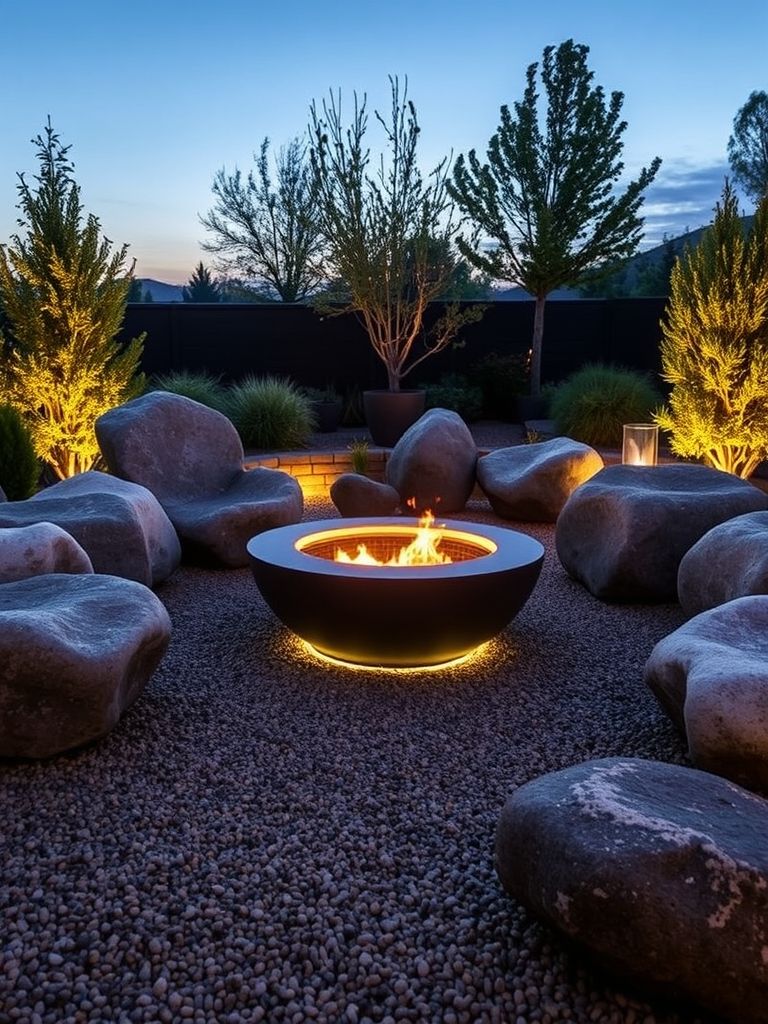
Rock Sculpture Garden With Desert Plants
Art needs negative space to breathe. Place one or two sculptural pieces first, then compose the planting and stone around them. The eye should rest on the artwork, not search for it. A restrained plant list suits the theme. Agaves, columnar cacti, yuccas, and euphorbias echo the vertical thrust of sculpture while staying low-maintenance. Keep foliage colors to a tight range.
Stone is your canvas. A wide field of gravel—buff, gray, or volcanic black—creates a gallery floor that recedes. A few strategic boulders can ground a tall piece without visual clutter. Circulation should feel like a quiet procession. A narrow path that reveals each work one at a time turns the garden into a series of moments rather than a single glance.
Night lighting can be theatrical. Gentle backlighting or low cross-light grazes texture and casts dramatic silhouettes. Avoid harsh front spots that flatten forms. With fewer elements, every detail matters. Keep lines crisp, remove distractions, and let weathering add character over time.
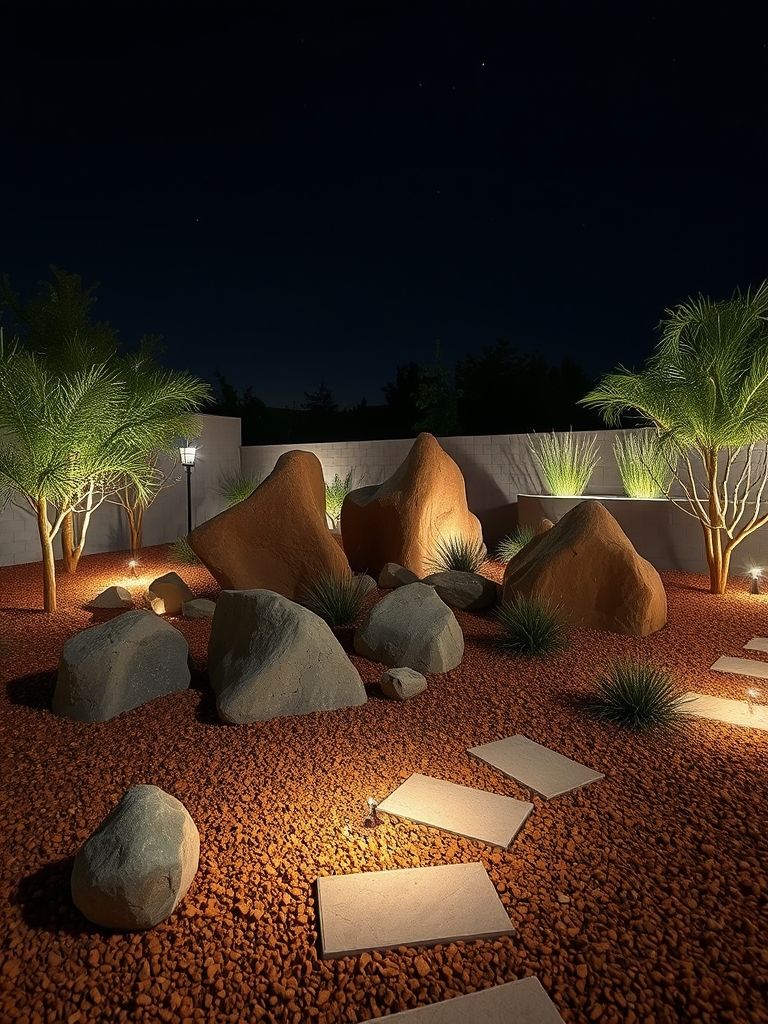
Succulent Rock Garden With Multi-Colored Gravel
Color can be structural. Bands of different gravel hues—ivory, rose, charcoal—become stripes that guide the eye through a tapestry of succulents. Edging between colors keeps lines clean. Mound the planting areas slightly so rosettes are on display. Good drainage and a sunny aspect make colors richer and reduce rot. Top-dress with fine gravel to finish.
Build a cast of contrasting forms. Echeveria, aeonium, crassula, and senecio mix flats, domes, and spikes in a way that feels lush without relying on blooms. Repeat favorites for cohesion. Pots and basins add height. A few shallow stone bowls planted tightly create jewelry-like focal points within the bed. Match the stone tone to the surrounding gravel for harmony.
Maintenance is mostly editing. Remove offsets to keep rosettes tidy and replant them to expand drifts. Replace any winter losses quickly so patterns don’t develop gaps. Winter protection can be subtle. Frost cloth hides behind a low hedge, ready to deploy on cold nights without spoiling the composition.

Tiered Rock Garden With Retaining Walls
Terracing tames slopes and multiplies planting space. Low, dry-stacked walls step the grade into comfortable, usable bands. Each terrace can host a distinct plant layer without erosion. Drainage is non-negotiable. Behind every wall, add compacted gravel and a perforated pipe to relieve pressure. Slightly batter the wall back into the slope for strength.
Stone size should scale with height. Taller walls want larger blocks, shorter terraces can use smaller stone. Consistent coursing makes the structure feel calm. Stairs stitch the levels together. Broad treads and low risers invite lingering and create landings for containers or small seating nooks. Light the steps for safe evening use.
Planting can cascade. Trailing thyme and campanula spill over edges while shrubs anchor corners. Perennials fill the middle bands for seasonal color. Check local codes for wall height limits and rail requirements. Building right the first time keeps the garden beautiful and safe for decades.
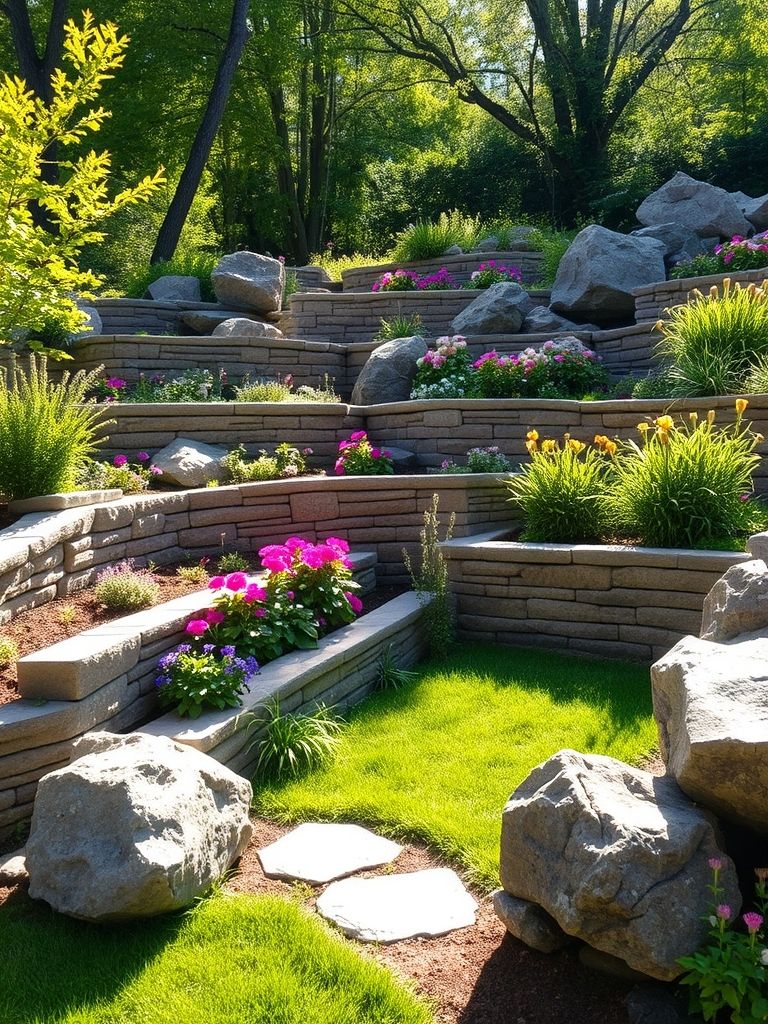
Tropical Rockscape With Palm Trees and White Pebbles
White pebbles are a backdrop for shadow play. Under palms, their fronds paint moving patterns that feel resort-like without being fussy. In hot climates, mix in gray to reduce glare. Choose palms for scale and climate. Windmill, pygmy date, or Mediterranean fan palms stay manageable in courtyards. Group in odd numbers for a relaxed, layered canopy.
Underplant with lush textures. Philodendrons, ferns, and bromeliads read tropical at a glance and love the filtered light. Keep species bold and leaves oversized. Irrigation should be targeted. Deep ring soaks at the palms and occasional sprays for underplantings maintain vigor without wasting water. Hide lines beneath the pebble field.
Furniture can lean low and loungey. Teak, woven resin, and canvas echo beach clubs without the maintenance burden. Keep fabrics light to bounce evening light. At night, up-light trunks softly and place tiny spikes at path edges. The goal is glow, not stadium brightness, so the palms’ movement remains the main act.
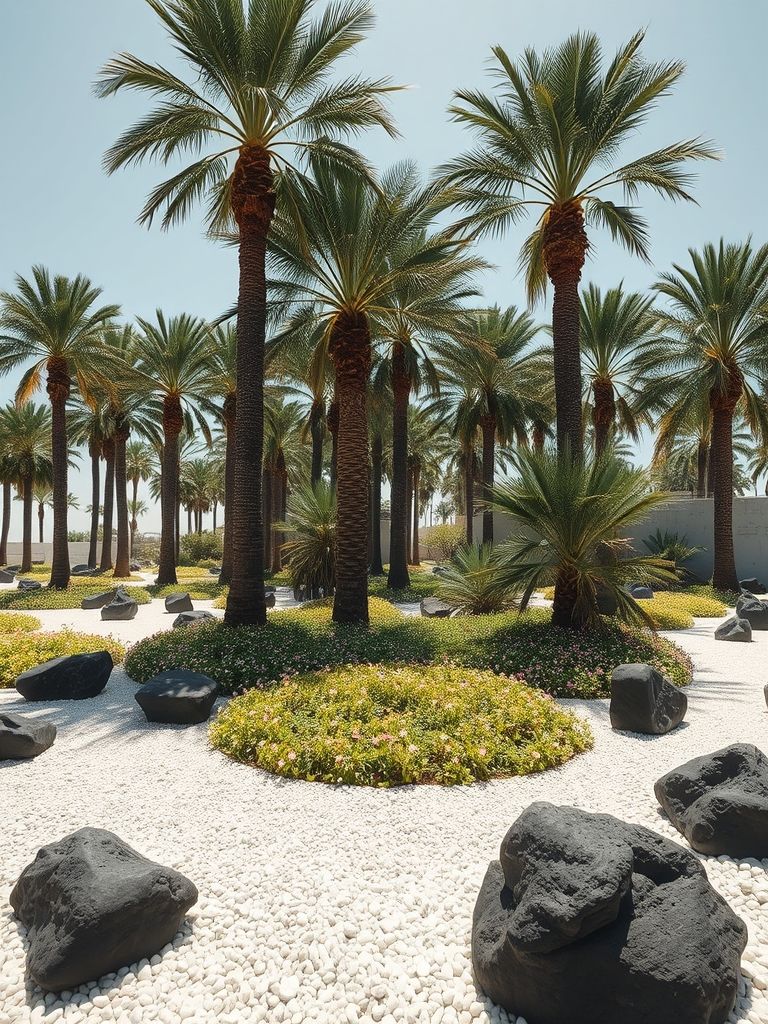
Zen Rock Garden With Raked Gravel and Stone Borders
Karesansui is about suggestion, not literal representation. Gravel becomes water, stone becomes island, and empty space becomes the sky. The discipline is calming and powerful. Group stones in odd numbers. One tall, one reclining, and a few lower companions create a natural hierarchy. Bury bases to the right depth so they feel born of the ground.
Raking is ritual. Simple ripple or straight-line patterns around stones invite focus and quiet the mind. Keep tools handy to refresh after wind or footfalls. Borders hold the void. Stone or slim steel edges keep gravel contained and draw a precise frame around the composition. Precision is part of the meditation.
Planting can be a whisper. A single pine, a clump of bamboo, or a moss patch is enough to suggest season and age without breaking the stillness. Restraint is the point. Maintenance becomes mindfulness. Sweeping, raking, and small adjustments are not chores but part of inhabiting the garden. It looks best when it’s cared for often, a little at a time.
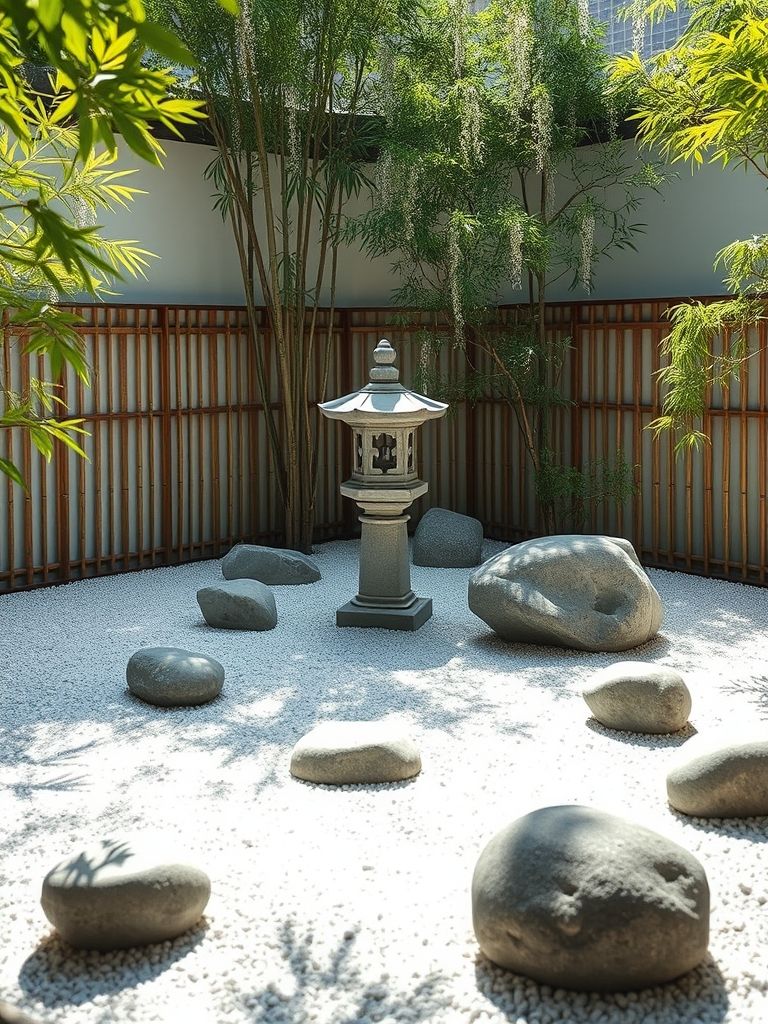
Conclusion on Rock Landscaping Ideas
Rock landscaping turns structure into style: lines that stay crisp, textures that hold interest, and plantings that thrive with less water and work. Whether you’re channeling desert drama, mountain calm, or zen restraint, the right stone, scale, and spacing will do most of the talking for you. Start with one area—a border, a path, or a dry creek—and build outward with repetition and restraint. The result is a yard that looks finished in every season and feels better the longer you live with it.

